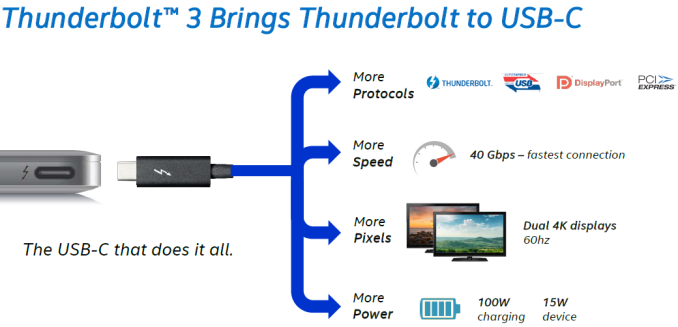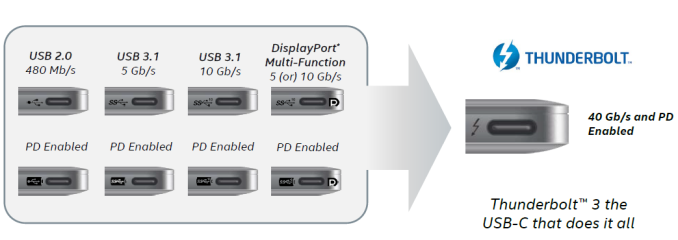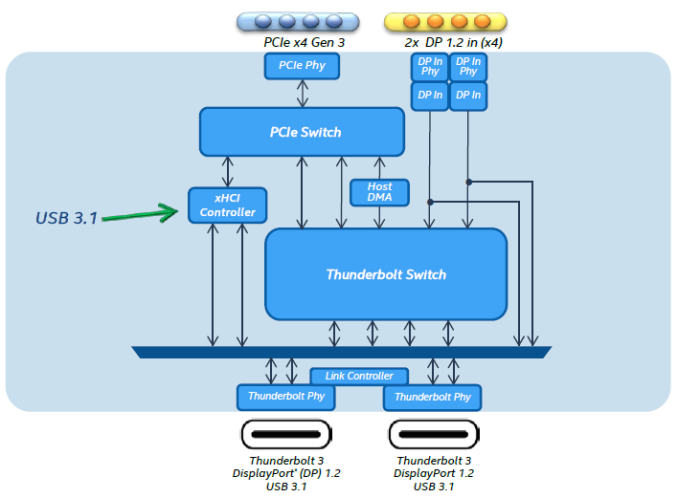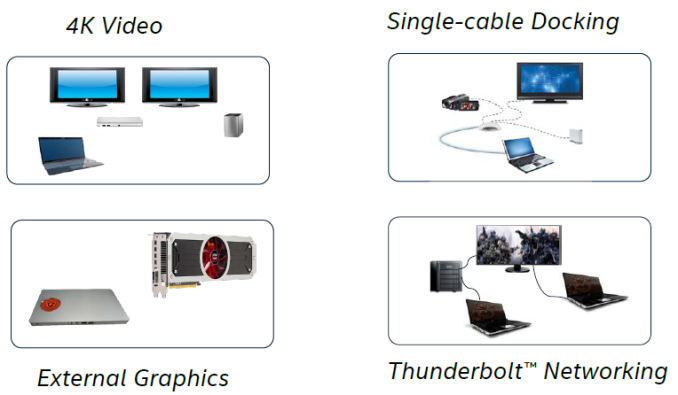Thunderbolt 3 in Action: Akitio Thunder3 Duo Pro DAS Review
by Ganesh T S on April 14, 2016 8:30 AM EST- Posted in
- Storage
- DAS
- Thunderbolt 3
- Akitio
The Nuts and Bolts of Thunderbolt 3
In order to understand and appreciate Thunderbolt 3, it is important to look at how Thunderbolt has evolved over the last five years. Thunderbolt was launched in 2011 to provide a unified interface with enough bandwidth to satisfy virtually everything needed simultaneously in terms of external I/O and display output. The first two versions shared the same cabling and connectors as mini-DisplayPort. They essentially muxed / demuxed PCIe lanes and DisplayPort lanes over a Thunderbolt cable using Thunderbolt controllers.
At the time of its launch, Thunderbolt was facing competition from USB 3.0 which had already seen a lot of adoption on the PC side. The parallels between USB 2.0 / FireWire and USB 3.0 / Thunderbolt were difficult to ignore. Even after Thunderbolt 2 was launched (with the ability to aggregate the two discrete bidirectional 10Gbps channels in the first version of Thunderbolt), the perception remained that it was relevant only to Mac users. Despite a number of PC components with Thunderbolt 2 integrated, Windows users never found the technology to live up to its advertised potential. Common complaints included peripherals not carrying certification for use on PCs, peripherals outright not working on PCs, unreliable hot-plugging and degraded performance compared to what one could obtain with the same device in a Mac.
In 2012, Intel luanched an Ivy Bridge NUC with Thunderbolt integrated. Unfortunately, the issues cited above resulted in Thunderbolt getting completely dropped from the NUC lineup. It was a golden chance for Intel to drive up Thunderbolt adoption, but, the overall peripheral market put a spanner in the works.
Thunderbolt 3 and Type-C
While the 'Thunderbolt for PCs' market was trying to build momentum, USB-IF started to finalize the specifications for USB 3.1 that could deliver up to 10 Gbps of theoretical bandwidth. By mid-2015, the USB consortium had announced both 10Gbps “Superspeed+” USB 3.1 Gen 2 and the new USB Type-C connector, a compact, reversible connector designed to drive the standard for the next decade or more. The introduction of USB Alternate Mode functionality – the ability for USB Type-C to carry other protocols along with (or instead of) USB Superspeed data – made USB more flexible than ever. VESA had also announced that DisplayPort would be supporting alternate mode to deliver DisplayPort video over USB Type-C ports and cables.
At Computex 2015, Intel announced Thunderbolt 3. It marked a shift in the signaling layer from what was used in Thunderbolt 1 and Thunderbolt 2. This was done in order to support more bandwidth per cable. By taking advantage of USB Type-C's alternate modes (i.e, the four high-speed data lanes in the Type-C specifications), Thunderbolt 3 became a standard built on top of the USB Type-C port.
Along with the change in the cable and connectors, Thunderbolt 3 also upgraded the total available bandwidth to 40 Gbps. Thunderbolt 3 also updated the active cables with electronics at both cable ends to support full bandwidth. With the usual Type-C cables, Thunderbolt 3 drops down to 20 Gbps.
Intel also markets Thunderbolt as the 'Type-C that does it all'. It is easy to see the reason behind this.
Consumers should always check the logo next to their Type-C port in order to identify the capabilities of the port in terms of the bandwidth available, power delivery capability and DisplayPort carriage support. Intel wants to bring it across to consumers that the Thunderbolt logo encompasses all these capabilities. Readers might wonder where the USB 3.1 capabilities suggested above come from. This is where the Alpine Ridge controller comes into the picture.
The Alpine Ridge Controller
Intel's chipsets usually take a generation or two after the introduction of any I/O version update (say, SATA II to SATA III, or, USB 2.0 to USB 3.0) before getting native support for the latest version. In the meanwhile, motherboard vendors resort to third-party bridge chips that interface with the PCH using PCIe lanes to provide the latest and greatest I/Os. The same thing is happening currently with USB 3.1, and this is where Intel has found a way to sneak in Thunderbolt support into more systems.
Intel's Thunderbolt 3 controller (Alpine Ridge) also integrates its own USB 3.1 (Superspeed+) host controller, which in turn serves dual purposes. When serving as a host controller for a USB Type-C port, this allows Alpine Ridge to directly drive USB 3.1 device if they’re plugged into an Alpine Ridge-backed Type-C port (similar to how DisplayPort works today with Thunderbolt ports). And when serving as a device controller (e.g. in a Thunderbolt monitor), this allows devices to utilize and/or offer USB 3.1 ports on their end.
Given that motherboard vendors integrate a USB 3.1 Gen 2 bridge chip in most mid-range and higher products, it actually costs them only a slight premium to go in for Alpine Ridge as compared to, say, an ASMedia bridge chip which can only provide USB 3.1 Gen 2 functionality.
Thunderbolt 3 Usage Scenarios
Thunderbolt 3 enables various scenarios such as a single-cable docking solution for charging, data transfer and display output, and external discrete GPU docks with hot-plug support.
Thunderbolt Networking also allows creation of a 10 Gbps network for peer-to-peer connection between various computing systems (based on a network adapter model in the host OS).
Given Intel's lofty goals with Thunderbolt 3, and the fact that systems with the ability to act as Thunderbolt 3 hosts have been shipping since late last year, it was imperative that various Thunderbolt 3 products enabling the above usage scenarios had to come to the market soon. The credit for being the first shipping Thunderbolt 3 peripheral goes to the Akitio Thunder3 Duo Pro. Intel and Akitio shipped us a couple of units so that we could check out the capabilities of Thunderbolt 3 in practical scenarios.
















60 Comments
View All Comments
DanNeely - Thursday, April 14, 2016 - link
Were there any issues with video quality/reliability in your daisy chaining test?I'm guessing not since you didn't come close to saturating the bus in this test, but I'd be really interested in seeing what happens if you ever get to play with something like a 10bay SSD enclosure and external GPU that could devour most of the bandwidth for what ever they're running.
ganeshts - Thursday, April 14, 2016 - link
The DisplayPort lanes are muxed together with the PCIe lanes, and, if any throttling were to happen, it would be on the PCIe lanes, and not the DisplayPort ones.But, yes, we were way short of saturating the link because we were not equipped properly to test that aspect.
DanNeely - Thursday, April 14, 2016 - link
Ok. I didn't know the DP lanes were given explicit preference in the MUXing; but I suppose that in general it's probably the right way to go.repoman27 - Thursday, April 14, 2016 - link
I just wanted to clarify that Thunderbolt supports multiple signaling modes over a single port via hardware muxing, however, when operating in Thunderbolt signaling mode, it uses protocol converters and crossbar switches to mux at the packet level. So the Thunderbolt mode is more like iSCSI or other technologies that encapsulate and transport data streams over IP networks alongside other packets. The encapsulation that Thunderbolt performs is incredibly lightweight, though, and Intel even refers to it as a "meta protocol".Thunderbolt seems to have fairly solid mechanisms in place for guaranteeing timely delivery of packets that are part of isochronous data streams such as DisplayPort. OG Thunderbolt did have some issues with USB audio adapters, as it had no way of knowing that the PCIe packets destined for the USB host controller in the device were particularly time sensitive.
Bear in mind that the signaling rate of a Thunderbolt PHY is considerably higher than the versions of PCIe or DisplayPort that it's carrying. Also, it can strip out all the bit-stuffing that is normally used to maintain a constant DisplayPort data rate and just send the packets carrying actual data. Or it can essentially bit-stuff with PCIe packets instead.
And one last niggle, Thunderbolt cables are really nothing like regular DisplayPort cables aside from sharing the miniDP connector. They're active and have four full-duplex signaling lanes, whereas DP cables are generally passive and only support half-duplex lanes for the main link.
DanNeely - Friday, April 15, 2016 - link
You say USB Audio was a problem with the original generation, does that mean it's not a problem in the 2nd/3rd generation? If so, how was it fixed: Throwing more bandwidth at the problem, or by doing usb packet inspection to ID and prioritize the usb audio stream?Also, am I right in assuming a TB dock with audio out would be using a built in usb audio device?
repoman27 - Saturday, April 16, 2016 - link
Here's Anand's description of the original problem: http://www.anandtech.com/show/4832/the-apple-thund...Honestly, I have no idea if the issue with the Promise Pegasus R6 drives (one of the very first Thunderbolt devices to make it to market) was ever fully resolved. In the meantime, Apple has released updates to their EFI, Thunderbolt host, device and cable firmware (yup, even the cables have firmware), and USB host controller and audio device drivers. If I had to guess, making the USB host controller / audio device drivers Thunderbolt aware and capable of isochronous bandwidth reservation (a la FireWire) might have solved the problem. However, Anand's conclusions about the root cause are different than mine, so I could be way off base.
And yes, AFAIK Thunderbolt docks all use USB devices in some form or another for audio I/O.
danbob999 - Thursday, April 14, 2016 - link
"the street price of $378 sounds reasonable"Sorry but no, a hard drive case is not worth $378. Wake me up when it cost less than $30.
NCM - Thursday, April 14, 2016 - link
On the off chance that you're just ignorant, not a troll, I'll point out that it's not a "hard drive case." This enclosure holds two drives, it provides a selection of hardware RAID options, and it has very high speed connectivity via Thunderbolt 3. It's also one of the first products of of it kind. Each one of those things adds cost.Yes it's not cheap, but this kind of product will become less expensive over time. For comparison purposes we have a bunch of 2.5" drive RAID enclosures at the office that run about $270 each (empty), see http://www.bhphotovideo.com/c/product/882789-REG/C...
danbob999 - Thursday, April 14, 2016 - link
This is a 2x3.5" case. It's too bulky to be useful for 2.5" SSDs. It's too expensive and no faster and a plain USB3 case when you put two 3.5" HDDs.I wasn't trolling, I seriously don't see any use case for it. The fact that it needs a fan to operate just make it worse.
Guspaz - Thursday, April 14, 2016 - link
Can you point out a 2x3.5" USB 3 hard drive enclosure with hardware RAID support for under $30? I get that you think $378 is too much, but $30 seems far more unreasonable a price than $378.